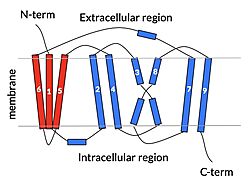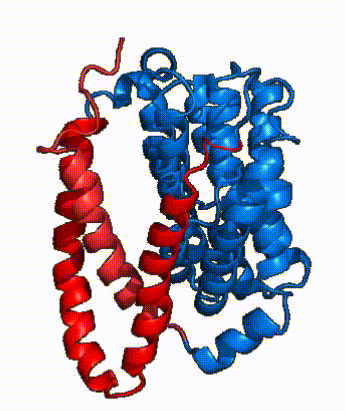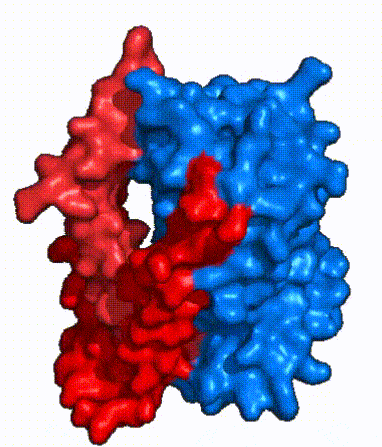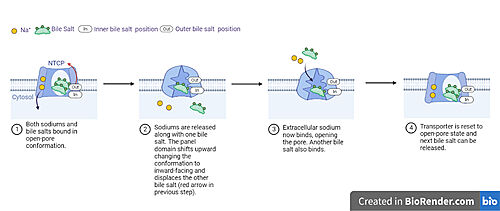Sandbox Reserved 1794
From Proteopedia
(Difference between revisions)
| Line 4: | Line 4: | ||
== Introduction == | == Introduction == | ||
| - | [[image:Taurocholate.png|thumb|250 px| '''Fig.1 Taruocholic acid a crystalline bile acid''' Shown here is the structure in a line representation of taruocholic acid with stereochemistry and important hydrogens.]] | + | [[image:Taurocholate.png|thumb|250 px| '''Fig.1: Taruocholic acid a crystalline bile acid''' Shown here is the structure in a line representation of taruocholic acid with stereochemistry and important hydrogens.]] |
Sodium Taurocholate Co-Transporting Polypeptide, or NTCP, is a [https://en.wikipedia.org/wiki/Membrane_transport_protein membrane transporter protein] found in the plasma membrane of [https://en.wikipedia.org/wiki/Hepatocyte hepatocytes]. NTCP's primary function is the transportation of [https://en.wikipedia.org/wiki/Taurocholic_acid taurocholates], or '''bile salts''', (Fig. 1) into the liver and out of the liver to the small intestine. <Ref> Stieger B. The role of the sodium-taurocholate cotransporting polypeptide (NTCP) and of the bile salt export pump (BSEP) in physiology and pathophysiology of bile formation. Handb Exp Pharmacol. 2011;(201):205-59. doi: 10.1007/978-3-642-14541-4_5. PMID: 21103971. [https://dx.doi.org/10.1007/978-3-642-14541-4_5 DOI: DOI: 10.1007/978-3-642-14541-4_5]. </Ref> Bile salts play various physiological roles in metabolism and digestion, but their main function is the [https://en.wikipedia.org/wiki/Emulsion emulsification] of lipid droplets into smaller fragments. This enables lipases to break down the droplets into their monomers, or triglycerides which are then able to be digested. NTCP is part of the [https://en.wikipedia.org/wiki/Solute_carrier_family solute carrier superfamily], SLC10. NTCP is the founding member of the SLC10 family, first discovered in rat hepatocytes in 1978. <ref name = "SLC10"> Geyer, J., Wilke, T. & Petzinger, E. The solute carrier family SLC10: more than a family of bile acid transporters regarding function and phylogenetic relationships. Naunyn Schmied Arch Pharmacol 372, 413–431 (2006). https://doi.org/10.1007/s00210-006-0043-8 </ref> NTCP has a key role in [https://en.wikipedia.org/wiki/Enterohepatic_circulation enterohepatic circulation] or '''bile salt recycling''', and its unique ability to transport other solutes gives it therapeutic potential for lowering cholesterol and treating [https://en.wikipedia.org/wiki/Liver_disease liver disease]. <Ref name = "Goutam"/> | Sodium Taurocholate Co-Transporting Polypeptide, or NTCP, is a [https://en.wikipedia.org/wiki/Membrane_transport_protein membrane transporter protein] found in the plasma membrane of [https://en.wikipedia.org/wiki/Hepatocyte hepatocytes]. NTCP's primary function is the transportation of [https://en.wikipedia.org/wiki/Taurocholic_acid taurocholates], or '''bile salts''', (Fig. 1) into the liver and out of the liver to the small intestine. <Ref> Stieger B. The role of the sodium-taurocholate cotransporting polypeptide (NTCP) and of the bile salt export pump (BSEP) in physiology and pathophysiology of bile formation. Handb Exp Pharmacol. 2011;(201):205-59. doi: 10.1007/978-3-642-14541-4_5. PMID: 21103971. [https://dx.doi.org/10.1007/978-3-642-14541-4_5 DOI: DOI: 10.1007/978-3-642-14541-4_5]. </Ref> Bile salts play various physiological roles in metabolism and digestion, but their main function is the [https://en.wikipedia.org/wiki/Emulsion emulsification] of lipid droplets into smaller fragments. This enables lipases to break down the droplets into their monomers, or triglycerides which are then able to be digested. NTCP is part of the [https://en.wikipedia.org/wiki/Solute_carrier_family solute carrier superfamily], SLC10. NTCP is the founding member of the SLC10 family, first discovered in rat hepatocytes in 1978. <ref name = "SLC10"> Geyer, J., Wilke, T. & Petzinger, E. The solute carrier family SLC10: more than a family of bile acid transporters regarding function and phylogenetic relationships. Naunyn Schmied Arch Pharmacol 372, 413–431 (2006). https://doi.org/10.1007/s00210-006-0043-8 </ref> NTCP has a key role in [https://en.wikipedia.org/wiki/Enterohepatic_circulation enterohepatic circulation] or '''bile salt recycling''', and its unique ability to transport other solutes gives it therapeutic potential for lowering cholesterol and treating [https://en.wikipedia.org/wiki/Liver_disease liver disease]. <Ref name = "Goutam"/> | ||
| Line 33: | Line 33: | ||
| [[Image:Surface_NTCP_morph.gif]] | | [[Image:Surface_NTCP_morph.gif]] | ||
|- | |- | ||
| - | | '''Fig. 3: NTCP shown as cartoons with <font color='red'><b>panel</b></font> and <font color='#6060ff'><b>core</b></font> domains colored.''' NTCP is shown entirely as cartoons colored by domain. The panel domain helices can be seen moving to close the pore. Here NTCP is rotated 180° from how it is normally oriented and is alternating from open-pore to inward-facing conformation (7PQQ to 7PQG) | + | | '''Fig. 3: NTCP shown as cartoons with <font color='red'><b>panel</b></font> and <font color='#6060ff'><b>core</b></font> domains colored.''' NTCP is shown entirely as cartoons colored by domain. The panel domain helices can be seen moving to close the pore. Here NTCP is rotated 180° from how it is normally oriented and is alternating from open-pore to inward-facing conformation (7PQQ to 7PQG). |
| - | | '''Fig. 4: NTCP surface representation with <font color='red'><b>panel</b></font> and <font color='#6060ff'><b>core</b></font> domains colored.''' NTCP is shown as surface representation colored by domain. The panel domain can be seen shifting to close the pore. Here NTCP is rotated 180° from how it is normally oriented and is alternating from open-pore to inward-facing conformation (7PQQ to 7PQG) | + | | '''Fig. 4: NTCP surface representation with <font color='red'><b>panel</b></font> and <font color='#6060ff'><b>core</b></font> domains colored.''' NTCP is shown as surface representation colored by domain. The panel domain can be seen shifting to close the pore. Here NTCP is rotated 180° from how it is normally oriented and is alternating from open-pore to inward-facing conformation (7PQQ to 7PQG). |
|} | |} | ||
Revision as of 21:55, 20 April 2023
Contents |
Sodium Taurocholate Co-Transporting Polypeptide
| |||||||||||
References
- ↑ Stieger B. The role of the sodium-taurocholate cotransporting polypeptide (NTCP) and of the bile salt export pump (BSEP) in physiology and pathophysiology of bile formation. Handb Exp Pharmacol. 2011;(201):205-59. doi: 10.1007/978-3-642-14541-4_5. PMID: 21103971. DOI: DOI: 10.1007/978-3-642-14541-4_5.
- ↑ Geyer, J., Wilke, T. & Petzinger, E. The solute carrier family SLC10: more than a family of bile acid transporters regarding function and phylogenetic relationships. Naunyn Schmied Arch Pharmacol 372, 413–431 (2006). https://doi.org/10.1007/s00210-006-0043-8
- ↑ 3.0 3.1 3.2 3.3 3.4 3.5 3.6 3.7 3.8 3.9 Goutam, K., Ielasi, F.S., Pardon, E. et al. Structural basis of sodium-dependent bile salt uptake into the liver. Nature 606, 1015–1020 (2022). DOI: 10.1038/s41586-022-04723-z.
- ↑ 4.0 4.1 4.2 4.3 4.4 Park, JH., Iwamoto, M., Yun, JH. et al. Structural insights into the HBV receptor and bile acid transporter NTCP. Nature 606, 1027–1031 (2022). https://doi.org/10.1038/s41586-022-04857-0.
- ↑ 5.0 5.1 5.2 5.3 5.4 Liu, H., Irobalieva, R.N., Bang-Sørensen, R. et al. Structure of human NTCP reveals the basis of recognition and sodium-driven transport of bile salts into the liver. Cell Res 32, 773–776 (2022). https://doi.org/10.1038/s41422-022-00680-4
- ↑ Qi X. and Li W. (2022). Unlocking the secrets to human NTCP structure. The Innovation 3(5), 100294. https://doi.org/10.1016/j.xinn.2022.100294
- ↑ Latorraca, N. R.; Fastman, N. M.; Venkatakrishnan, A. J.; Frommer, W. B.; Dror, R. O.; Feng, L. Mechanism of Substrate Translocation in an Alternating Access Transporter. Cell 2017, 169 (1), 96–107.
- ↑ 8.0 8.1 8.2 8.3 Asami, J., Kimura, K.T., Fujita-Fujiharu, Y. et al.Structure of the bile acid transporter and HBV receptor NTCP. Nature 606, 1021–1026 (2022). https://doi.org/10.1038/s41586-022-04845-4
- ↑ Grove, J.; Marsh, M. The Cell Biology of Receptor-Mediated Virus Entry. Journal of Cell Biology 2011, 195 (7), 1071–1082.
- ↑ 10.0 10.1 Herrscher C, Roingeard P, Blanchard E. Hepatitis B Virus Entry into Cells. Cells. 2020 Jun 18;9(6):1486. doi: 10.3390/cells9061486. PMID: 32570893; PMCID: PMC7349259.
PDB Files
Bile salts and sodium ions bound: 7zyi Open-pore NTCP: 7pqq Inward-facing NTCP: 7pqg
Student Contributors
- Isabelle White
- Lena Barko





